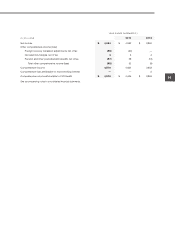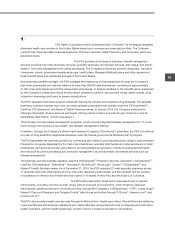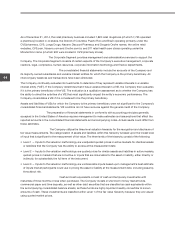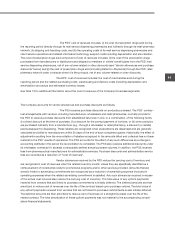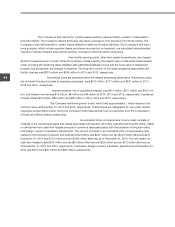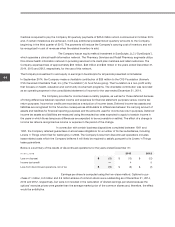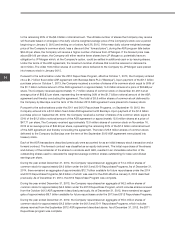CVS 2014 Annual Report Download - page 64
Download and view the complete annual report
Please find page 64 of the 2014 CVS annual report below. You can navigate through the pages in the report by either clicking on the pages listed below, or by using the keyword search tool below to find specific information within the annual report.
CVS Health
62
Notes to Consolidated Financial Statements
suggesting generic alternatives where clinically appropriate and approving the prescription for dispensing. Although
the PSS does not have credit risk with respect to Retail Co-Payments, management believes that all of the other
applicable indicators of gross revenue reporting are present. For contracts under which the PSS acts as an agent,
revenue is recognized using the net method.
Drug Discounts
—
The PSS deducts from its revenues any rebates, inclusive of discounts and fees, earned by its
clients. Rebates are paid to clients in accordance with the terms of client contracts, which are normally based on
fixed rebates per prescription for specific products dispensed or a percentage of manufacturer discounts received
for specific products dispensed. The liability for rebates due to clients is included in “Claims and discounts payable”
in the accompanying consolidated balance sheets.
Medicare Part D —
The PSS, through its SilverScript subsidiary, participates in the federal government’s Medicare
Part D program as a Prescription Drug Plan (“PDP”). Net revenues include insurance premiums earned by the PDP,
which are determined based on the PDP’s annual bid and related contractual arrangements with the Centers for
Medicare and Medicaid Services (“CMS”). The insurance premiums include a direct premium paid by CMS and
a beneficiary premium, which is the responsibility of the PDP member, but is subsidized by CMS in the case of
low-income members. Premiums collected in advance are initially deferred in accrued expenses and are then
recognized in net revenues over the period in which members are entitled to receive benefits.
In addition to these premiums, net revenues include co-payments, coverage gap benefits, deductibles and
co-insurance (collectively, the “Member Co-Payments”) related to PDP members’ actual prescription claims.
In certain cases, CMS subsidizes a portion of these Member Co-Payments and pays the PSS an estimated pro-
spective Member Co-Payment subsidy amount each month. The prospective Member Co-Payment subsidy
amounts received from CMS are also included in net revenues. SilverScript assumes no risk for these amounts.
If the prospective Member Co-Payment subsidies received differ from the amounts based on actual prescription
claims, the difference is recorded in either accounts receivable or accrued expenses.
The PSS accounts for CMS obligations and Member Co-Payments (including the amounts subsidized by CMS)
using the gross method consistent with its revenue recognition policies for Mail Co-Payments and Retail
Co-Payments (discussed previously in this document).
Retail Pharmacy Segment
The RPS recognizes revenue at the time the customer takes possession of the merchandise. Customer returns are
not material. Revenue generated from the performance of services in the RPS’ health care clinics is recognized at
the time the services are performed. Sales taxes are not included in revenue.
Loyalty Program —
The Company’s customer loyalty program, ExtraCare®, is comprised of two components:
ExtraSavingsTM and ExtraBucks® Rewards. ExtraSavings coupons redeemed by customers are recorded as a
reduction of revenues when redeemed. ExtraBucks Rewards are accrued as a charge to cost of revenues when
earned, net of estimated breakage. The Company determines breakage based on historical redemption patterns.
See Note 12 for additional information about the revenues of the Company’s business segments.



